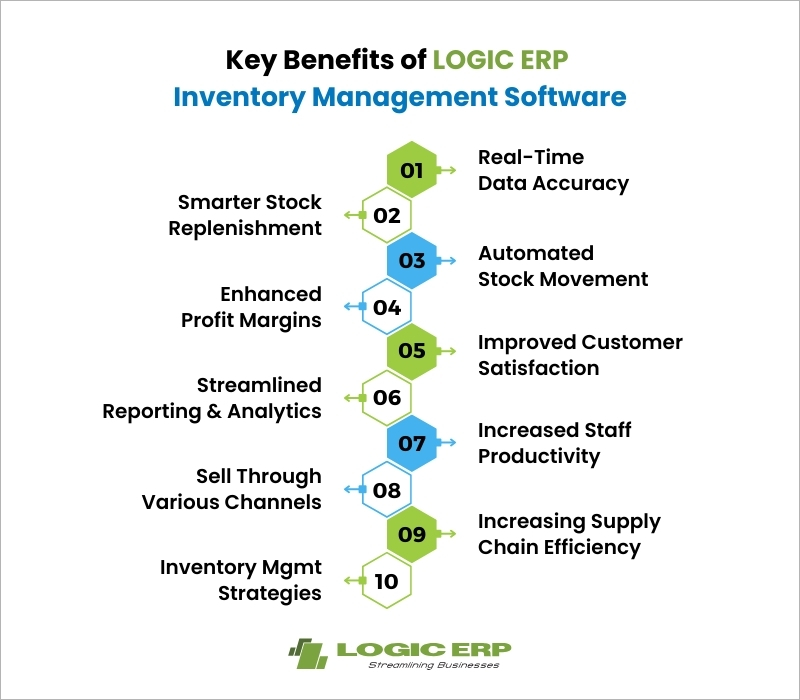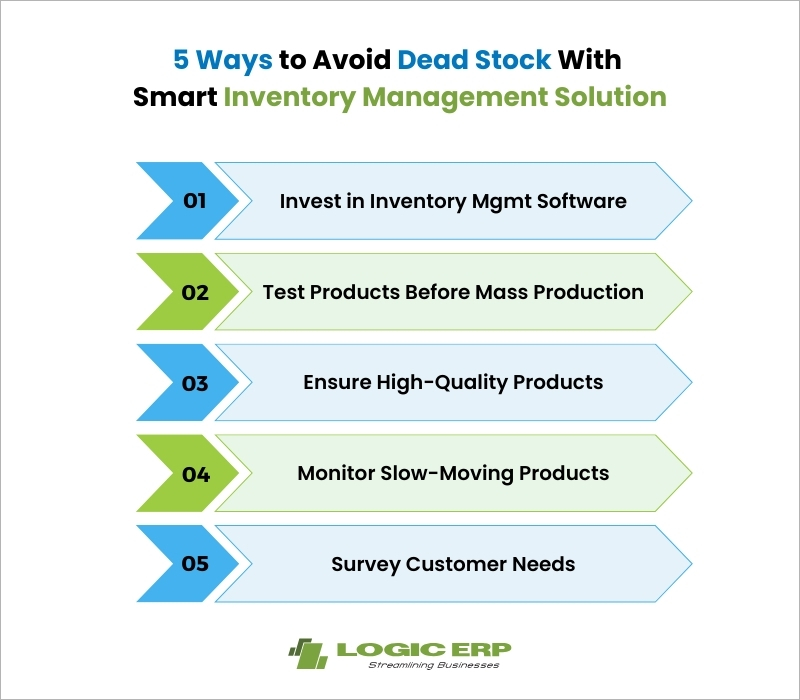

Looking for the best inventory management software for your retail, manufacturing and distribution business? Get LOGIC ERP | the best inventory control solution for dead stock, supply chain management today!
Introduction
Managing inventory effectively is a framework of success for retail businesses, and one of the most persistent challenges they face is dealing with dead stock. Dead stock represents inventory that remains unsold, leading to wasted resources and financial losses. If you are dealing with dead stock: managing your inventory has become a headache for you, then it’s time to get supply chain management software today!
In 2025, advanced Inventory Management Software i.e. LOGIC ERP, offers a comprehensive solution to eliminate dead stock and optimize inventory control.
What is Dead Stock?
Dead stock refers to items or products in inventory that fail to sell over a significant period. These items or products might have gone out of style, become obsolete, or lost relevance in the market. Dead stock becomes an alarming issue for retailers because it not only ties up valuable capital but also takes up storage spaces that could be used for more profitable items.
Why is Dead Stock Bad for Retail, Manufacturing and Distribution Businesses?
Dead stock in any business create a ripple of challenges:
1. Financial Drain: Businesses incur losses on the cost of goods, storage, and labor required to manage unsold stock.
2. Devalued or Expired Products: Products like food or cosmetics that sit on shelves for too long are at a higher risk of depreciating in value, becoming obsolete, getting damaged or expiring. Smartphones and cards usually depreciate over time and after the release of the new version, it becomes difficult to deal with the old stock.
3. Reduced Operational Efficiency: Dead stock takes up storage space and complicates inventory tracking, slowing down overall operations.
4. Missed Opportunities: By occupying space and capital, dead stock prevents businesses from investing in high-demand products.
5. Increased Employee Wages: With more stock on shelves also increases its maintenance, requiring more employees to manage it. Processes like reshuffling, counting items, dead stock and disposal also won’t bring profitable return to the businesses.
6. Customer Dissatisfaction: Offering outdated or irrelevant stock can damage a brand’s reputation and drive customers toward competitors.
Read more: LOGIC ERP Inventory Management Software | A Complete Guide to Increase Business Profitability
What Causes Dead Stock?
Dead stock doesn’t just happen by chance—it’s often the result of preventable issues. There can be various causes for dead stock in retail, manufacturing and distribution business management. Some of the major causes resulting in dead stock are listed below:
1. Inaccurate Demand Forecasting:
Poor forecasting methods can lead to over-ordering products that don’t match customer demand.
2. Market Misjudgment:
Failing to anticipate market trends or understand customer preferences results in stocking items that don’t sell.
3. Quality Issues:
Low-quality products are more likely to be returned or left unsold, contributing to dead stock.
4. Inefficient Inventory Control:
Without reliable Inventory Control Software i.e. LOGIC ERP, retailers may overlook slow-moving or stagnant products until it’s too late.
5. Seasonal Products:
Items tied to specific seasons or events can become dead stock once their time passes. For instance, leftover Halloween decorations may become irrelevant by November.
Read more: LOGIC ERP Inventory Management Software for Grocery Kirana Stores | Top Features & Benefits
How Does LOGIC ERP Software Eliminate Dead Stock to Transform Your Retail Inventory Management?
LOGIC ERP | The best stock management software provides a robust solution for businesses struggling with dead stock. As a leading Retail ERP Software, it integrates cutting-edge tools to analyze, track, and manage inventory effectively. Get the best solution to manage your inventory with the LOGIC ERP software solution today!
Here’s how LOGIC ERP addresses dead stock challenges:
1. Comprehensive Visibility:
LOGIC ERP offers real-time insights into inventory movement, enabling retailers to identify slow-moving items early. By understanding which products are at risk of becoming dead stock, businesses can take proactive measures.
2. Demand-Driven Stocking
The software includes advanced demand forecasting capabilities, ensuring that stock levels align with actual customer demand. This minimizes the risk of overstocking and dead stock accumulation.
3. Seamless Automation
LOGIC ERP automates inventory tracking and reporting, eliminating human error and improving efficiency.
4. Actionable Insights
With analytics tools, retailers can monitor trends, identify popular products, and make informed stocking decisions.
For instance, a retailer using LOGIC ERP might notice through analytics that a specific line of shoes is selling slower than expected. The system can suggest markdowns or promotional campaigns to clear the stock before it becomes dead inventory.
Read more: Unveiling the role of manufacturing ERP in streamlining inventory and supply chain management
Key Benefits of LOGIC ERP Inventory Control Software for Stock Management
LOGIC ERP comprehensive feature set makes it one of the best inventory management software for small businesses and large enterprises alike. Here are some of the standout benefits of using retail inventory management software:

1. Real-Time Data Accuracy
Real-time inventory updates ensure businesses always have an accurate view of their stock. This reduces errors, prevents overstocking, and ensures faster response times for replenishing popular items.
2. Smarter Stock Replenishment
LOGIC ERP leverages predictive analytics to optimize restocking decisions. By accurately predicting demand, the software ensures that only the right amount of inventory is ordered, reducing waste and costs.
3. Automated Stock Movement
One of the top benefits of using inventory management software is automation. The software tracks stock movement across warehouses and retail outlets, ensuring efficient rotation and preventing inventory from becoming obsolete.
4. Enhanced Profit Margins
By addressing dead stock issues of restaurants, LOGIC ERP inventory management software helps businesses cut costs and improve profitability. Automated workflows and optimized stock management translate to significant savings.
5. Improved Customer Satisfaction
Always having the right products in stock ensures a seamless shopping experience for customers. Whether online or in-store, customers can find what they need without delays.
6. Streamlined Reporting & Analytics
With powerful reporting tools, LOGIC ERP inventory management software provides actionable insights into inventory trends. Retailers can track sales performance, monitor stock levels, and evaluate the profitability of individual product lines.
7. Increased Staff Productivity
Digitized inventory control with LOGIC ERP stock management software enables you to plan, schedule, and control all warehouse activities. It also helps to optimize workflows while streamlining processes, saving employees time and money spent on warehouse operations.
8. Simpler to Sell Through Various Channels
A smart inventory management solution like LOGIC ERP makes it easier to sell through a new channel or market. It also helps to maintain data in a single central database, giving you access to your goods sold across various locations as well as control over selling merchandise in multiple marketplaces at the same time.
9. Increasing Supply Chain Efficiency
Advanced stock management solutions allow you to gain more control over your supply chain and implement a diversification plan more efficiently. Having many vendors decreases the danger of protracted product wait periods when one of the suppliers is unable to deliver on time.
10. Inventory Management Strategies
The inventory management system offers capabilities that allow the retailers, manufacturers and distributors to select from a variety of advanced inventory management approaches. These include: as First in First Out, First Expired First Out, Just in Time, and ABC Analysis for your business setup and put focus on generating growth.
5 Ways to Avoid Dead Stock With Smart Inventory Management Solutions
Dead stock management is a must to consider aspect for every business. It is important to know how to get rid of dead stock when necessary, it’s even better to avoid having dead stock in the first place. Better inventory management, quality control and research into customer needs can help.

1. Invest in Inventory Management Software
Using a reliable retail ERP inventory control solution like LOGIC ERP is the most effective way to combat dead stock. By automating inventory tracking, forecasting demand, and identifying slow-moving items, LOGIC ERP empowers businesses to stay ahead of challenges.
2. Test Products Before Mass Production
Launching new products carries risks. By testing items in small batches before committing to large-scale production, retailers can gauge market demand and avoid overstocking. For instance, a retailer planning to introduce a new line of summer dresses could conduct a limited pre-launch sale to measure customer interest.
3. Ensure Products Are High-Quality
Quality assurance plays an important role in customer satisfaction. Products that meet or exceed expectations are less likely to remain unsold. Regular quality checks and working with reputable suppliers are essential steps.
4. Monitor Slow-Moving Products
Using advanced ERP software like LOGIC ERP, businesses can identify slow-moving inventory early. Implementing strategies like discounts, bundling, or targeted promotions can help move these products before they become dead stock.
5. Survey Customer Needs
Understanding customer preferences is key to stocking the right products. Regular surveys, feedback collection, and trend analysis of LOGIC ERP inventory management can help retailers stay aligned with customer expectations.
Why Industries Trust LOGIC ERP: The Best Solution for Modern Business Challenges?
LOGIC ERP stands out among retail management software options for its ability to address industry-specific inventory management challenges Its robust features make it an indispensable tool for modern retailers.
Read more: How to Select the Best Grocery Inventory Management Software in 2025?
Customizable for Every Business
LOGIC ERP offers a high degree of customization, making it suitable for businesses of all sizes. From small boutiques to large retail chains, LOGIC ERP inventory management software for grocery store operations control adapts to individual needs.
User-Friendly Interface
The intuitive design of LOGIC ERP ensures quick onboarding and ease of use, even for employees with limited technical expertise.
Integration With Other Systems
LOGIC ERP integrates seamlessly with other tools like Supply Chain Management Software and point-of-sale systems, creating a unified management platform.
Proven Track Record
Retailers across various industries trust LOGIC ERP for its reliability, scalability, and ability to deliver measurable results.
Conclusion
Dead stock is more than just a minor inconvenience—it’s a significant threat to a retailer’s profitability and operational efficiency. In 2025, the importance of advanced ERP software for inventory management cannot be negotiated. Businesses dealing in retail, manufacturing and distribution need advanced solutions like LOGIC ERP to tackle this challenge head-on.
By providing real-time insights, automation, and actionable analytics, LOGIC ERP empowers retailers to eliminate dead stock, streamline operations, and boost profitability. Whether you’re running a small business or managing a large retail chain, LOGIC ERP has proven to be the best solution for modern inventory management.
Take control of your inventory today. Choose LOGIC ERP for the best dead stock management with inventory software and transform the way you manage your retail business.
If you are interested in automating your inventory management with LOGIC ERP? Book a free ERP live demo by calling our experts at +91-734114 1176 or send us an email at sales@logicerp.com today!
Frequently Asked Questions (FAQ)
What is dead stock?
Dead stock for small business and large scale industries refers to unsold inventory that remains stagnant for a long time and has little to no chance of being sold.
What causes dead stock?
Common causes of dead stock include overstocking, lack of demand forecasting, poor product quality, and seasonal shifts.
How can I prevent dead stock?
Opt for advanced inventory management software i.e. LOGIC ERP – a perfect solution to manage stocks for small businesses and large scale industries. This inventory control software has proven to be the best solution for accurate demand forecasting, monitor slow-moving products, and conduct regular market analysis.
What are the consequences of dead stock?
Consequences of dead stock in retail, manufacturing and distribution business leads to financial losses, increased storage costs, and disruptions in the supply chain.
How do I calculate the cost of dead stock?
The cost of dead stock includes purchase price, storage fees, and any additional costs for handling or disposal.
What is the difference between dead stock and slow-moving inventory?
Dead stock is unsellable, while slow-moving inventory still has potential demand but sells at a much slower rate.
How can I manage deadstock effectively with inventory management software?
Opt for strategies with LOGIC ERP inventory management software including: offering discounts, repurposing products, or donating them to clear space.
What is the impact of dead stock on cash flow?
Dead stock ties up capital that could be invested in profitable products, affecting cash flow negatively.
How can I identify dead stock in my inventory?
Use advanced inventory management software like LOGIC ERP retail software solution to track stock movement and identify stagnant items.
What are some strategies to reduce dead stock?
Invest in quality products, optimize stock levels, and use Dead Stock Inventory Management Software like LOGIC ERP for automation.



